2006 NISSAN QUEST remove seats
[x] Cancel search: remove seatsPage 25 of 352
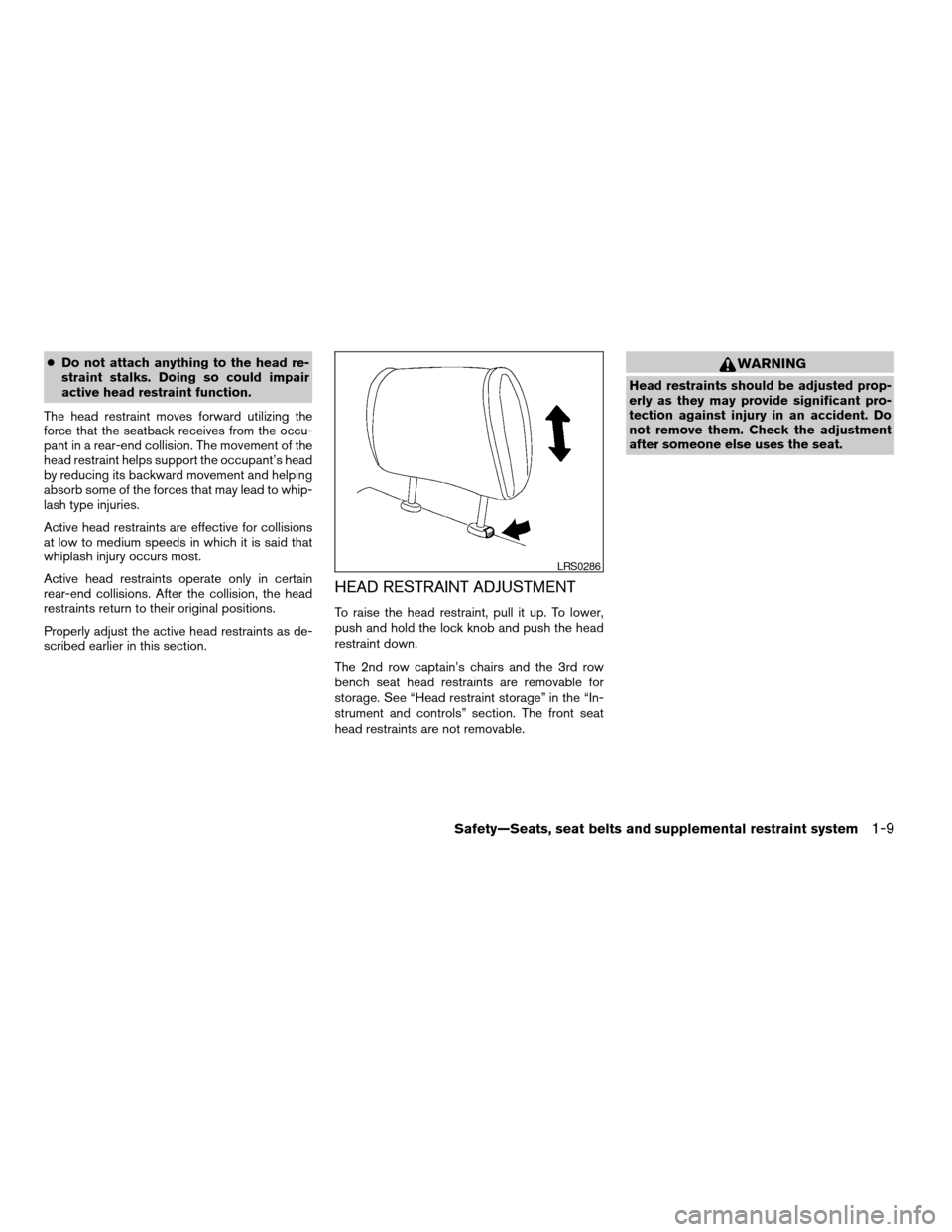
cDo not attach anything to the head re-
straint stalks. Doing so could impair
active head restraint function.
The head restraint moves forward utilizing the
force that the seatback receives from the occu-
pant in a rear-end collision. The movement of the
head restraint helps support the occupant’s head
by reducing its backward movement and helping
absorb some of the forces that may lead to whip-
lash type injuries.
Active head restraints are effective for collisions
at low to medium speeds in which it is said that
whiplash injury occurs most.
Active head restraints operate only in certain
rear-end collisions. After the collision, the head
restraints return to their original positions.
Properly adjust the active head restraints as de-
scribed earlier in this section.
HEAD RESTRAINT ADJUSTMENT
To raise the head restraint, pull it up. To lower,
push and hold the lock knob and push the head
restraint down.
The 2nd row captain’s chairs and the 3rd row
bench seat head restraints are removable for
storage. See “Head restraint storage” in the “In-
strument and controls” section. The front seat
head restraints are not removable.
WARNING
Head restraints should be adjusted prop-
erly as they may provide significant pro-
tection against injury in an accident. Do
not remove them. Check the adjustment
after someone else uses the seat.
LRS0286
Safety—Seats, seat belts and supplemental restraint system1-9
ZREVIEW COPYÐ2006 Quest(van)
Owners ManualÐUSA_English(nna)
05/27/05Ðtbrooks
X
Page 26 of 352
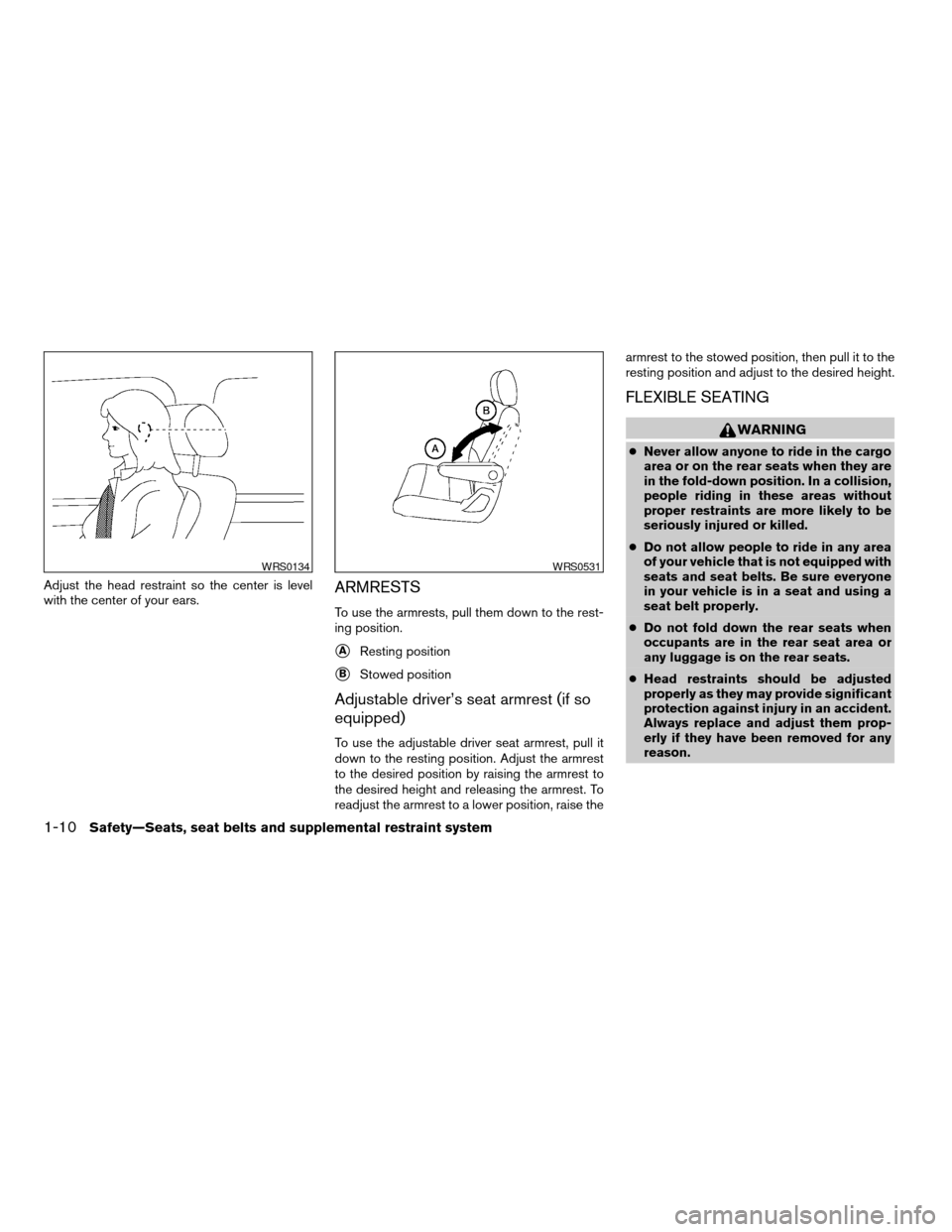
Adjust the head restraint so the center is level
with the center of your ears.ARMRESTS
To use the armrests, pull them down to the rest-
ing position.
sAResting position
sBStowed position
Adjustable driver’s seat armrest (if so
equipped)
To use the adjustable driver seat armrest, pull it
down to the resting position. Adjust the armrest
to the desired position by raising the armrest to
the desired height and releasing the armrest. To
readjust the armrest to a lower position, raise thearmrest to the stowed position, then pull it to the
resting position and adjust to the desired height.
FLEXIBLE SEATING
WARNING
cNever allow anyone to ride in the cargo
area or on the rear seats when they are
in the fold-down position. In a collision,
people riding in these areas without
proper restraints are more likely to be
seriously injured or killed.
cDo not allow people to ride in any area
of your vehicle that is not equipped with
seats and seat belts. Be sure everyone
in your vehicle is in a seat and using a
seat belt properly.
cDo not fold down the rear seats when
occupants are in the rear seat area or
any luggage is on the rear seats.
cHead restraints should be adjusted
properly as they may provide significant
protection against injury in an accident.
Always replace and adjust them prop-
erly if they have been removed for any
reason.
WRS0134WRS0531
1-10Safety—Seats, seat belts and supplemental restraint system
ZREVIEW COPYÐ2006 Quest(van)
Owners ManualÐUSA_English(nna)
05/27/05Ðtbrooks
X
Page 27 of 352
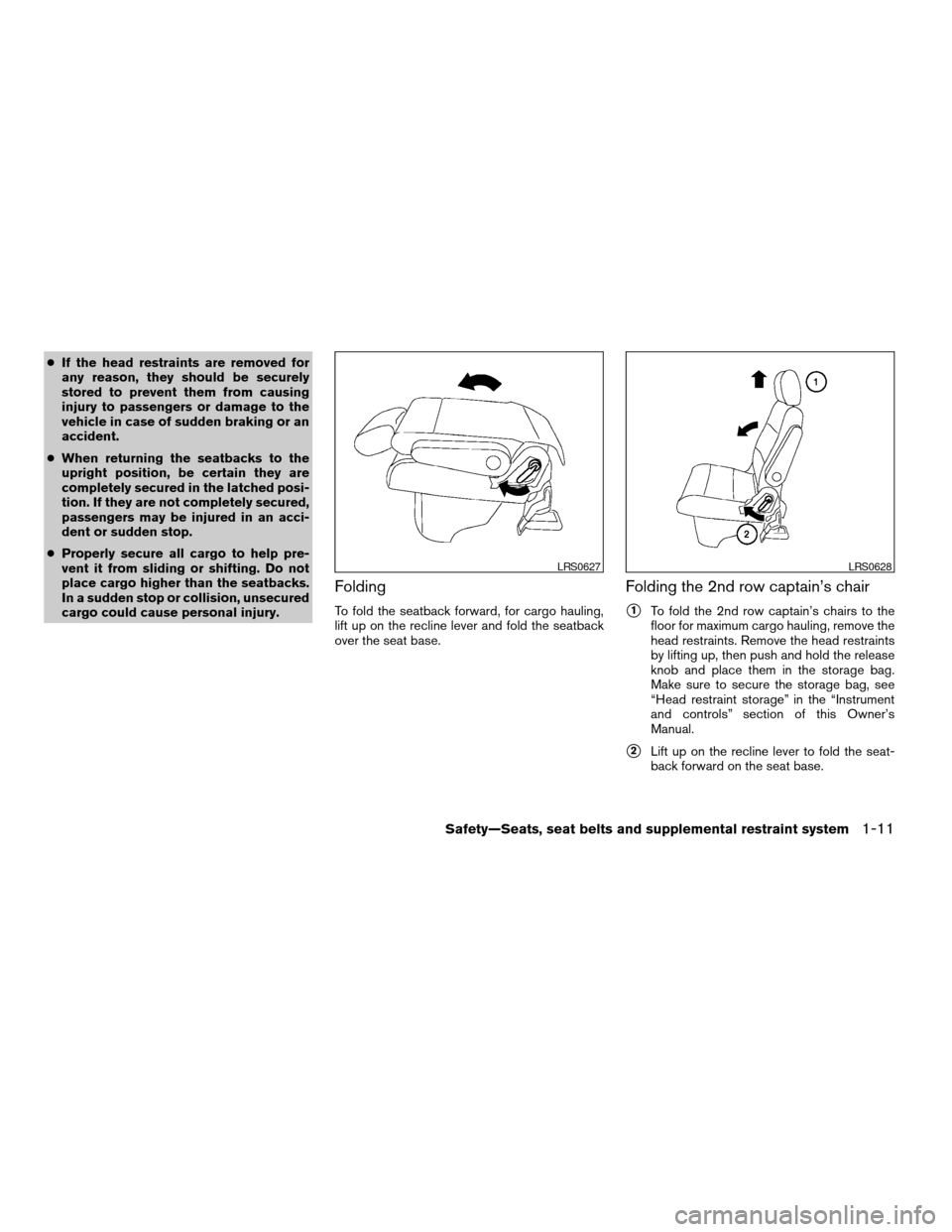
cIf the head restraints are removed for
any reason, they should be securely
stored to prevent them from causing
injury to passengers or damage to the
vehicle in case of sudden braking or an
accident.
cWhen returning the seatbacks to the
upright position, be certain they are
completely secured in the latched posi-
tion. If they are not completely secured,
passengers may be injured in an acci-
dent or sudden stop.
cProperly secure all cargo to help pre-
vent it from sliding or shifting. Do not
place cargo higher than the seatbacks.
In a sudden stop or collision, unsecured
cargo could cause personal injury.
Folding
To fold the seatback forward, for cargo hauling,
lift up on the recline lever and fold the seatback
over the seat base.
Folding the 2nd row captain’s chair
s1To fold the 2nd row captain’s chairs to the
floor for maximum cargo hauling, remove the
head restraints. Remove the head restraints
by lifting up, then push and hold the release
knob and place them in the storage bag.
Make sure to secure the storage bag, see
“Head restraint storage” in the “Instrument
and controls” section of this Owner’s
Manual.
s2Lift up on the recline lever to fold the seat-
back forward on the seat base.
LRS0627LRS0628
Safety—Seats, seat belts and supplemental restraint system1-11
ZREVIEW COPYÐ2006 Quest(van)
Owners ManualÐUSA_English(nna)
05/27/05Ðtbrooks
X
Page 29 of 352
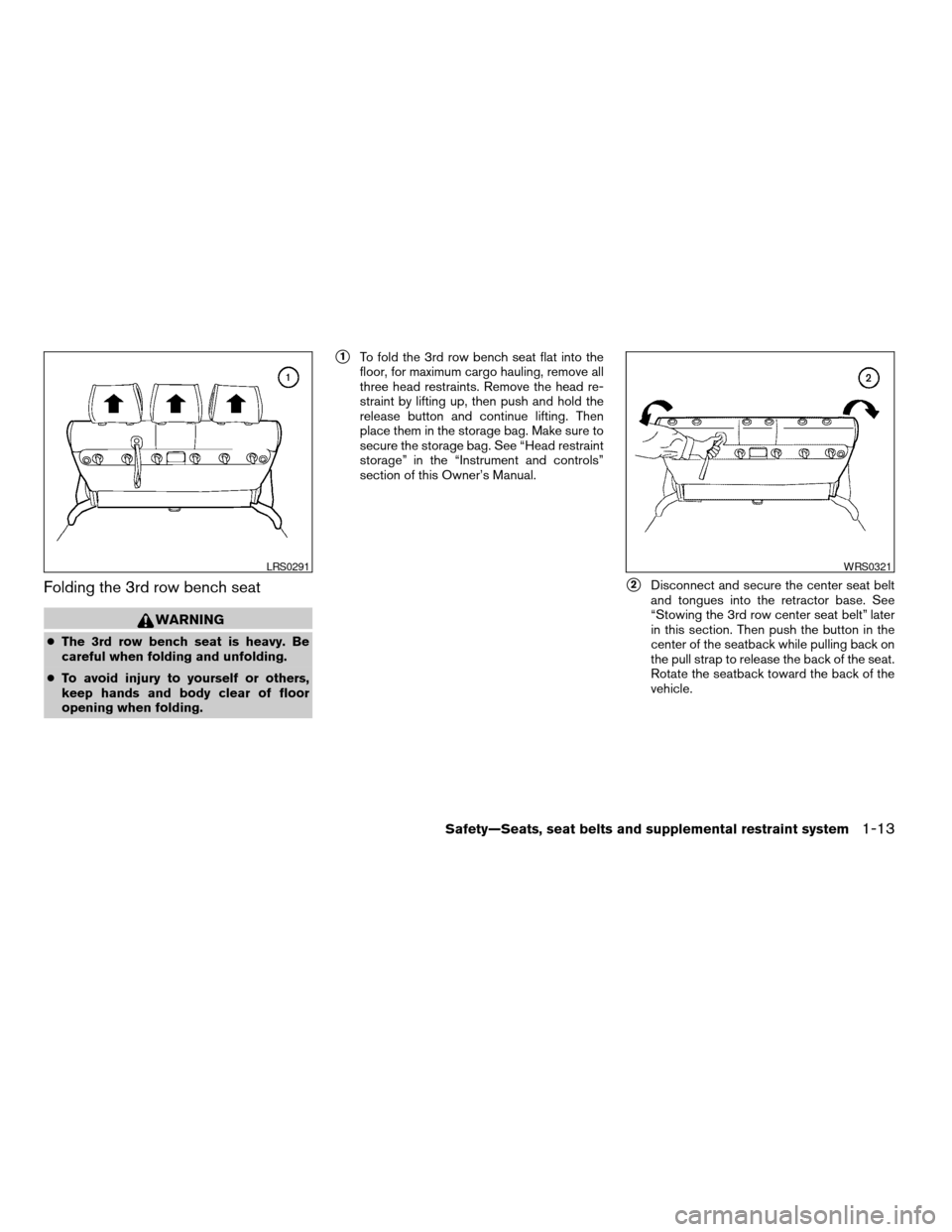
Folding the 3rd row bench seat
WARNING
cThe 3rd row bench seat is heavy. Be
careful when folding and unfolding.
cTo avoid injury to yourself or others,
keep hands and body clear of floor
opening when folding.
s1To fold the 3rd row bench seat flat into the
floor, for maximum cargo hauling, remove all
three head restraints. Remove the head re-
straint by lifting up, then push and hold the
release button and continue lifting. Then
place them in the storage bag. Make sure to
secure the storage bag. See “Head restraint
storage” in the “Instrument and controls”
section of this Owner’s Manual.
s2Disconnect and secure the center seat belt
and tongues into the retractor base. See
“Stowing the 3rd row center seat belt” later
in this section. Then push the button in the
center of the seatback while pulling back on
the pull strap to release the back of the seat.
Rotate the seatback toward the back of the
vehicle.
LRS0291WRS0321
Safety—Seats, seat belts and supplemental restraint system1-13
ZREVIEW COPYÐ2006 Quest(van)
Owners ManualÐUSA_English(nna)
05/27/05Ðtbrooks
X
Page 30 of 352
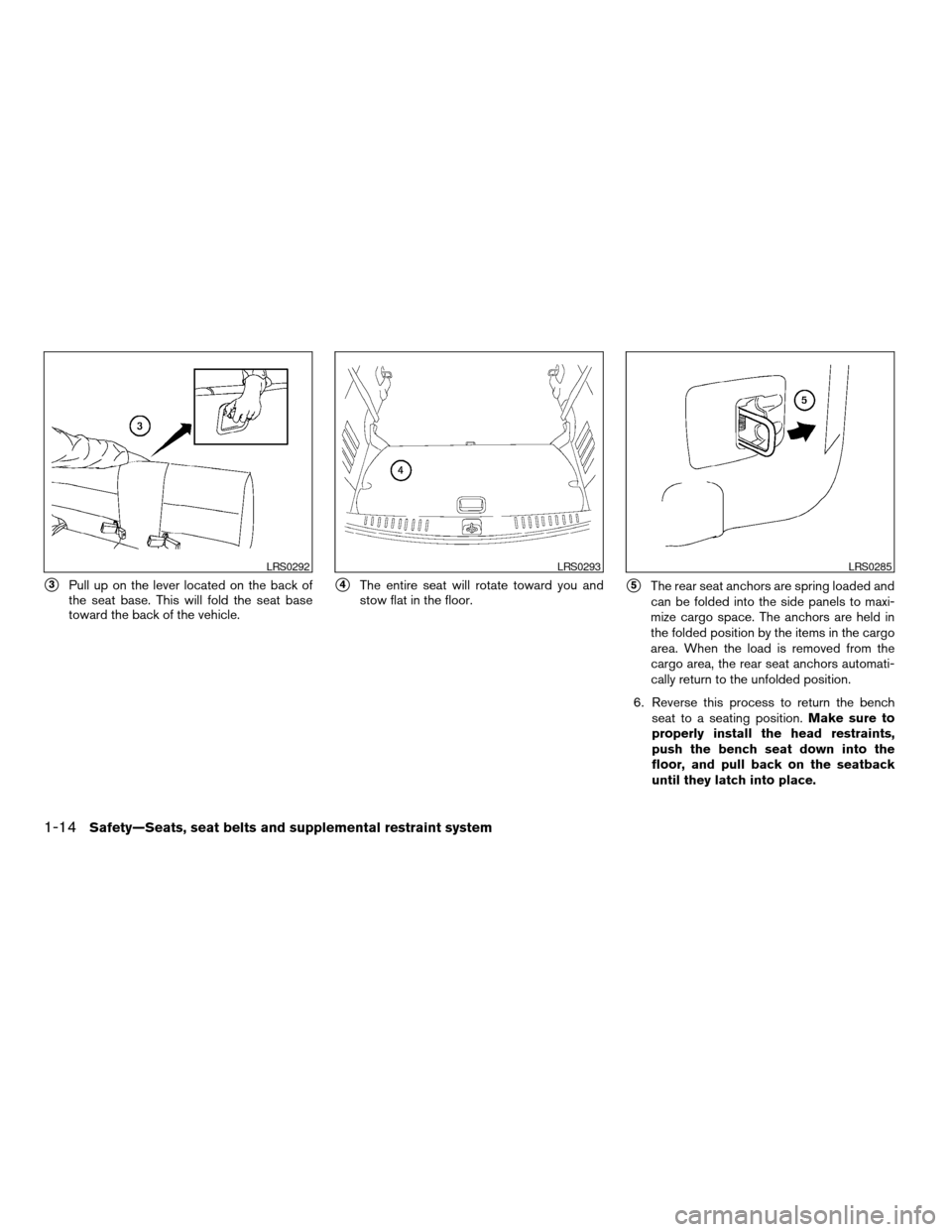
s3Pull up on the lever located on the back of
the seat base. This will fold the seat base
toward the back of the vehicle.s4The entire seat will rotate toward you and
stow flat in the floor.s5The rear seat anchors are spring loaded and
can be folded into the side panels to maxi-
mize cargo space. The anchors are held in
the folded position by the items in the cargo
area. When the load is removed from the
cargo area, the rear seat anchors automati-
cally return to the unfolded position.
6. Reverse this process to return the bench
seat to a seating position.Make sure to
properly install the head restraints,
push the bench seat down into the
floor, and pull back on the seatback
until they latch into place.
LRS0292LRS0293LRS0285
1-14Safety—Seats, seat belts and supplemental restraint system
ZREVIEW COPYÐ2006 Quest(van)
Owners ManualÐUSA_English(nna)
05/27/05Ðtbrooks
X
Page 43 of 352
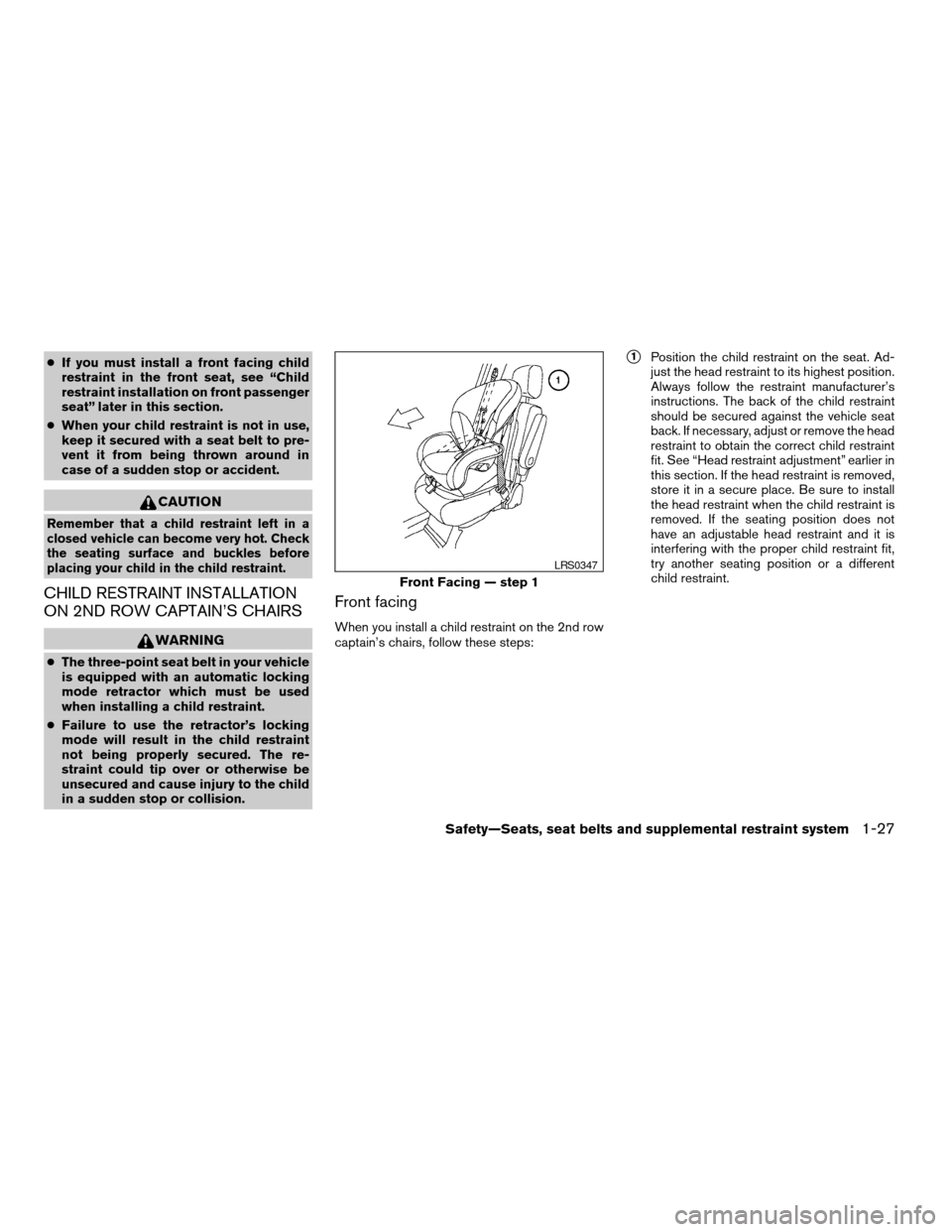
cIf you must install a front facing child
restraint in the front seat, see “Child
restraint installation on front passenger
seat” later in this section.
cWhen your child restraint is not in use,
keep it secured with a seat belt to pre-
vent it from being thrown around in
case of a sudden stop or accident.
CAUTION
Remember that a child restraint left in a
closed vehicle can become very hot. Check
the seating surface and buckles before
placing your child in the child restraint.
CHILD RESTRAINT INSTALLATION
ON 2ND ROW CAPTAIN’S CHAIRS
WARNING
cThe three-point seat belt in your vehicle
is equipped with an automatic locking
mode retractor which must be used
when installing a child restraint.
cFailure to use the retractor’s locking
mode will result in the child restraint
not being properly secured. The re-
straint could tip over or otherwise be
unsecured and cause injury to the child
in a sudden stop or collision.
Front facing
When you install a child restraint on the 2nd row
captain’s chairs, follow these steps:
s1Position the child restraint on the seat. Ad-
just the head restraint to its highest position.
Always follow the restraint manufacturer’s
instructions. The back of the child restraint
should be secured against the vehicle seat
back. If necessary, adjust or remove the head
restraint to obtain the correct child restraint
fit. See “Head restraint adjustment” earlier in
this section. If the head restraint is removed,
store it in a secure place. Be sure to install
the head restraint when the child restraint is
removed. If the seating position does not
have an adjustable head restraint and it is
interfering with the proper child restraint fit,
try another seating position or a different
child restraint.
Front Facing — step 1
LRS0347
Safety—Seats, seat belts and supplemental restraint system1-27
ZREVIEW COPYÐ2006 Quest(van)
Owners ManualÐUSA_English(nna)
05/27/05Ðtbrooks
X
Page 44 of 352

s2Route the seat belt tongue through the child
restraint and insert it into the buckle until you
hear and feel the latch engage.
Be sure to follow the child restraint manu-
facturer’s instructions for belt routing.s3Pull on the shoulder belt until all of the belt is
fully extended. At this time, the seat belt
retractor is in the automatic locking mode
(child restraint mode) . It reverts back to
emergency locking mode when the seat belt
is fully retracted.s4Allow the seat belt to retract. Pull up on the
shoulder belt to remove any slack in the belt.
Front Facing — step 2
LRS0615
Front Facing — step 3
LRS0616
Front Facing — step 4
LRS0457
1-28Safety—Seats, seat belts and supplemental restraint system
ZREVIEW COPYÐ2006 Quest(van)
Owners ManualÐUSA_English(nna)
05/27/05Ðtbrooks
X
Page 45 of 352

s5Before placing the child in the child restraint,
use force to push the child restraint from
side to side, and tug it forward to make sure
that it is securely held in place. It should not
move more than 1 inch (25 mm) . If it does
move more than 1 inch (25 mm) , pull again
on the shoulder belt to further tighten the
child restraint. If unable to properly secure
the restraint move the restraint to another
rear seating position and try again , or try a
different child restraint. Not all child re-
straints fit in all types of vehicles.6. Check that the retractor is in the automatic
locking mode by trying to pull more seat belt
out of the retractor. If you cannot pull any
more belt webbing out of the retractor, the
retractor is in the automatic locking mode.
7. Check to make sure that the child restraint is
properly secured prior to each use. If the belt
is not locked, repeat steps 3 through 6.
After the child restraint is removed and the seat
belt is fully retracted, the automatic locking mode
(child restraint mode) is canceled.Rear facing
When you install a child restraint on the 2nd row
captain’s chair, follow these steps:
s1Position the child restraint on the seat. Al-
ways follow the restraint manufacturer’s in-
structions.
Front Facing — step 5
LRS0617
Rear Facing — step 1
WRS0301
Safety—Seats, seat belts and supplemental restraint system1-29
ZREVIEW COPYÐ2006 Quest(van)
Owners ManualÐUSA_English(nna)
05/27/05Ðtbrooks
X